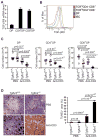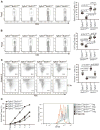Transforming growth factor-beta signaling curbs thymic negative selection promoting regulatory T cell development
- PMID: 20471291
- PMCID: PMC2880228
- DOI: 10.1016/j.immuni.2010.04.012
Transforming growth factor-beta signaling curbs thymic negative selection promoting regulatory T cell development
Abstract
Thymus-derived naturally occurring regulatory T (nTreg) cells are necessary for immunological self-tolerance. nTreg cell development is instructed by the T cell receptor and can be induced by agonist antigens that trigger T cell-negative selection. How T cell deletion is regulated so that nTreg cells are generated is unclear. Here we showed that transforming growth factor-beta (TGF-beta) signaling protected nTreg cells and antigen-stimulated conventional T cells from apoptosis. Enhanced apoptosis of TGF-beta receptor-deficient nTreg cells was associated with high expression of proapoptotic proteins Bim, Bax, and Bak and low expression of the antiapoptotic protein Bcl-2. Ablation of Bim in mice corrected the Treg cell development and homeostasis defects. Our results suggest that nTreg cell commitment is independent of TGF-beta signaling. Instead, TGF-beta promotes nTreg cell survival by antagonizing T cell negative selection. These findings reveal a critical function for TGF-beta in control of autoreactive T cell fates with important implications for understanding T cell self-tolerance mechanisms.
Copyright 2010 Elsevier Inc. All rights reserved.
Conflict of interest statement
The authors declare that they have no competing financial interests.
Figures







Comment in
-
TGF-Beta to the rescue.Immunity. 2010 May 28;32(5):585-7. doi: 10.1016/j.immuni.2010.04.014. Immunity. 2010. PMID: 20510867
-
Regulatory T cells: Nurtured by TGFbeta.Nat Rev Immunol. 2010 Jul;10(7):466. doi: 10.1038/nri2812. Nat Rev Immunol. 2010. PMID: 20589991 No abstract available.
-
TGF-β promotes immune suppression by inhibiting Treg cell apoptosis.Immunotherapy. 2010 Sep;2(5):608. Immunotherapy. 2010. PMID: 20919442 No abstract available.
References
-
- Anderson MS, Venanzi ES, Chen Z, Berzins SP, Benoist C, Mathis D. The cellular mechanism of Aire control of T cell tolerance. Immunity. 2005;23:227–239. - PubMed
-
- Apostolou I, Sarukhan A, Klein L, von Boehmer H. Origin of regulatory T cells with known specificity for antigen. Nat Immunol. 2002;3:756–763. - PubMed
-
- Bouillet P, Purton JF, Godfrey DI, Zhang LC, Coultas L, Puthalakath H, Pellegrini M, Cory S, Adams JM, Strasser A. BH3-only Bcl-2 family member Bim is required for apoptosis of autoreactive thymocytes. Nature. 2002;415:922–926. - PubMed
-
- Bouneaud C, Kourilsky P, Bousso P. Impact of negative selection on the T cell repertoire reactive to a self-peptide: a large fraction of T cell clones escapes clonal deletion. Immunity. 2000;13:829–840. - PubMed
Publication types
MeSH terms
Substances
Grants and funding
LinkOut - more resources
Full Text Sources
Other Literature Sources
Molecular Biology Databases
Research Materials

